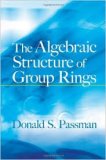السلام عليكم ورحمة الله وبركاته
كتاب
The Algebraic Structure of Group Rings
Donald S. Passman
1979

Highly recommended by the Bulletin of the London Mathematical Society, this comprehensive, self-contained treatment of group rings was written by an authority on the subject. Suitable for graduate students, it was hailed by the Bulletin of the American Mathematical Society as "a majestic account… encyclopedic and lucid."1985 edition
http://www.amazon.com/Algebraic-Structure-Group-Rings-Mathematics/dp/0486482065
رابط التحميل (ملف djvu وليس pdf)
[hide]
[/hide]
بالتوفيق إن شاء الله
كتاب
The Algebraic Structure of Group Rings
Donald S. Passman
1979

Highly recommended by the Bulletin of the London Mathematical Society, this comprehensive, self-contained treatment of group rings was written by an authority on the subject. Suitable for graduate students, it was hailed by the Bulletin of the American Mathematical Society as "a majestic account… encyclopedic and lucid."1985 edition
http://www.amazon.com/Algebraic-Structure-Group-Rings-Mathematics/dp/0486482065
رابط التحميل (ملف djvu وليس pdf)
[hide]
كود:
http://bookzz.org/book/827018/e8c86bبالتوفيق إن شاء الله
